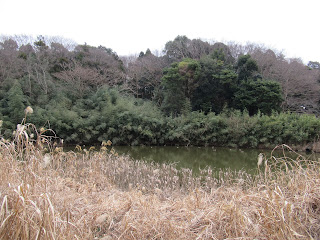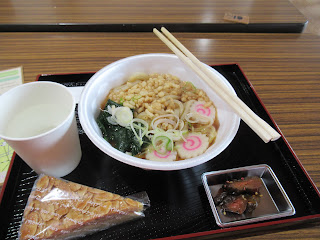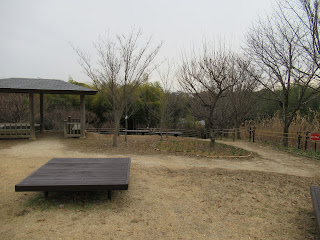I personally think we have a colder-than-usual winter this year. Yeah, not much snow has fallen in Yokohama or Tokyo, but the minimum temperature of a day has continued to be below zero. Even though, Japan Meteorological Agency forecasts we’ll have warmer than average weather next month and beyond. These couple of days could be the last cold spell … We long for spring to come. And the main event of Japanese spring is CHERRY BLOSSOMS!!! Many meteorologists estimate we’ll have a slightly earlier opening of cherry blossoms this year in Metropolis Tokyo area. It may be on 19th or 20th of March. Mmmmmmmmmmmmmmmmmm. Not only warmer days of spring but also cold enough days of winter are needed for cherry trees to have a beautiful opening. Sufficiently long, cold, windy days kick off the sleep of buds to prepare nice opening, the scholars say. We have had a very cold winter this year … I hope we can expect spectacular blossoms next month!
 |
| Winter buds for Lindera umbellata are also longing for spring. |
But COVID is still roaming around town. It would be difficult to have noisy parties under cherry trees on crowded streets. Having said that, not all Japanese like boisterous flower get-together in downtowns. Actually, many aficionados say the best cherry blossoms place in Tokyo is not in town. The spot we should go is the mountainous border between Tokyo and Kanagawa prefectures, i.e. the ridge way of Mt. Takao 高尾山. From this week, I’ll tell you about my adventure with cherry blossoms in Mt. Takao area.
This is one of the most popular hiking destinations in Japan. There are many approaches to start this ridge way fun. My recommended course goes like this:
Start: Jimba-kohgen-shita Bus Stop 陣馬高原下 (toilet spot)
From the bus stop +20 min: Entering the trekking road to Mt. Jimba 陣馬山
From the above point +60 min: The peak, Mt. Jimba, ASL 855m (toilet spot)
From Mt. Jimba +40 min: Myo-oh Pass 明王峠, ASL 738m (toilet spot)
From Myo-oh Pass +10 min: Sokozawa Pass 底沢峠, ASL 721m
From Sokozawa Pass +30 min: Mt. Doh-dokoro 堂所山, ASL 731m
From Mt. Doh-dokoro +60 min: The Peak, Mt. Kagenobu 景信山, ASL 727.3m (toilet spot)
From Mt. Kagenobu +30 min: Kobotoke Pass 小仏峠, ASL 548m
From Kobotoke Pass +30 min: Mt. Shiroyama 城山, ASL 670m (toilet spot)
From Mt. Shiroyama +70 min: The peak, Mt. Takao, ASL 599m (toilet spot)
From Mt. Takao +50min: The cable car station, ASL 480m (toilet spot)
I think this is the easiest way to conquer the course. Caution: yep, there are lots of toilets in this itinerary, but please do not expect all are open. Fully utilize any chance you encounter, just in case. Open poop is not recommended for the reason of nature conservation: half the itinerary of today is in Quasi-national Park, aka Meiji Forest Takao Quasi-national Park 明治の森高尾国定公園.
 |
| The
toilet at Jimba-kohgen-shita Bus Stop. I think this one is reliably open every day. |
In this blog, we’ve already visited some peaks for “Tokyo’s best” cherry blossoms’ itinerary. We’ve been to Mt. Takao, ASL 599.3m (; my posts on December 15th and 22nd, 2017). And the starting point for ridge walk is Mt. Jimba (; my post on May 24th, 2019). Connecting these two peaks is a popular one-day hike which walks roughly 20km for 8 hours or so (meal-times included). It is said that the course is good for novices of ridge walk in Japan. In winter some peaks could be covered in snow. So, I recommend if you’re new to Japanese ridge walk, wait until middle March to try. It would be just about-time for cherry blossoms. 😇
 |
| It is
a damned-well maintained hiking road. There are lots of signpost with English translation like this all the way. |
The peak of cherry blossoms of this course is roughly 2 weeks after the full bloom in Chidorigafuchi Moat of the Imperial Palace 千鳥ヶ淵, but sometimes it could be earlier. I took this course last year approx. 10 days after the full bloom in downtown Tokyo. It was a close call. Cherry blossoms can be gone completely within a day or two after full bloom. Measuring the timing of your hike could be one of the most important things to witness the splendid flowers of Tokyo. You can check the HP of Mt. Takao Visitor Center daily during the season to know the situation. Also, thanks to the COVID the crowd once gathered in Shibuya 渋谷 or Ginza 銀座 are now flocking around Mt. Takao especially for weekends. Inevitably people have started to notice the best cherry blossoms in Tokyo. This means, if you plan to go there on Saturday or Sunday for cherry blossoms, probably many people would think exactly the same as you do: “It is the only chance of a year for me to admire the beau.” The condition under the cherry trees may not be much different from that for Ueno Park 上野公園 or Meguro River 目黒川. Hey, it’s COVID. Take a day-off in weekdays to breathe deeply clean mountain air, without fears of airborne infection …
 |
| In
front of the Visitor Center of Mt. Takao, with cherry blossoms and people. It was late weekday afternoon, FYI. |
For the prep, these are standard hiking cautions:
Next week, I tell you the detail of this course. Please stay tuned!
- Wear your best-fit walking shoes, protective gloves, and a hat. It’s a long walk.
- Don long sleeves and pants. As this is for Japanese mountains there are several bushes of sasa-bamboos or the like to traverse. Their leaves can cut your skin easily. Also, during the cherry blossoms season it will still be cold in the ASL 500m+ area. Prepare accordingly.
- Carry a map of the area, a compass, a headlight (just in case), a rechargeable battery, your cell phone, and a first aid kit.
- Water, water, water and food = lunch and snacks. Though, there are several mountain cafés on today’s course. You can try their offerings which are several times more expensive than the same menu in downtown. Also, the route has designated areas where we can use our outdoor gas burner, i.e. we can cook our lunch. If you don’t mind carrying extra weight for home, nay, mountain-cook, please do. (Please remember water availability is extremely limited.) Oh, of course we strictly have to use those particular places for cooking. To prevent mountain fires, you know?
 |
| A café
in Myo-oh Pass was closed early spring last year on a weekday. |
Next week, I tell you the detail of this course. Please stay tuned!
P.s. The Cherry Blossoms Festival in Matsuda Town 松田町さくらまつり I told you on January 14th has now postponed their closing from February 20th to March 6th. It’s still very cold, and there is not much flowers yet as of February 20th. Fingers crossed for Cerasus × kanzakura ‘Kawazu-zakura’ to flower before 6th …
 |
| But wintersweets in Yadoriki are in their final bloom now … |
If you find environmental issues in Kanagawa Prefecture, please make a contact with Kanagawa Natural Environment Conservation Center 神奈川県自然環境保全センター
657 Nanasawa, Atsugi City, 243-0121
〒243-0121 厚木市七沢657
Phone: 046-248-0323
You can send an enquiry to them by clicking the bottom line of their homepage at http://www.pref.kanagawa.jp/div/1644/




















































